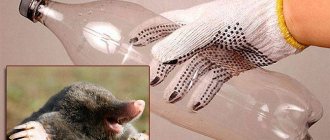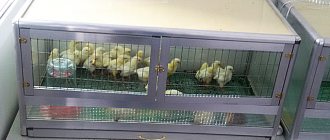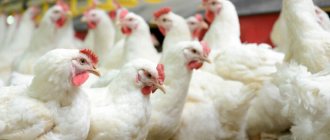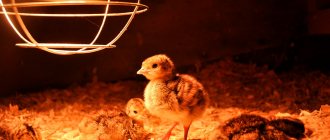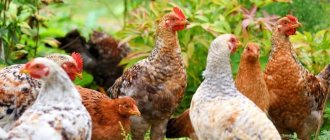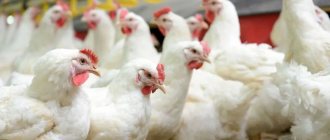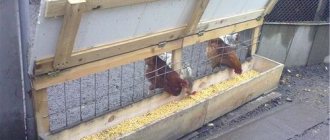Raising chickens at home is a difficult and responsible business. Young chickens are very capricious in terms of maintenance and require increased attention.
It is necessary not only to properly organize food and care, but also to take care of the equipment of the premises, compliance with temperature conditions and the prevention of diseases.
How to choose?
When choosing chickens to raise at home, you need to take into account age and sex characteristics.
In addition, the selection of young animals is carried out according to external characteristics. If the chicks are healthy :
- they have a toned stomach;
- umbilical cord;
- there are no signs of bleeding;
- the fluff is shiny and even.
Age
The optimal age for acquiring chicks remains 20 days. It is not difficult to raise healthy chickens at home from this age; they no longer depend on laying hens, they are able to feed on their own and find food for themselves.
Rooster or chicken?
The choice here must be taken into account for what purpose the farmer intends to raise the chicks. If for the sake of eggs, then you should choose breeding chicken breeds. Both rooster and chicken are suitable for meat. In addition, a rooster is necessary to increase the egg production of laying hens .
Nutrition
food should be appropriate for the age of the chicks
This is especially important for meat birds such as broilers. You should also add vitamins and nutritional supplements to your food.
You shouldn’t be overzealous with them if you want to get an environmentally friendly product, but you also shouldn’t neglect them, since a lack of necessary substances will negatively affect the development of babies. It is best to consult a veterinarian before taking the drug.
The first time to give food to chickens is after hatching, 12-16 hours later. Before this, the chicks must dry out. In nature, the first time they eat is the remains of the fetal yolk. Many owners follow this path, giving their babies finely crushed boiled yolk. Some veterinarians advise giving corn grits for the first time. Food for chickens should be served not in a bowl, but on a board or cardboard: this way the kids will learn to eat, since they don’t have a mother to show them what and how to do.
What to feed chickens
What should you give chickens to drink in the first days of life in order to build immunity and not harm them? In addition to food, chicks also need water. If it is of poor quality, it is better to pass it through a filter or disinfect it with potassium permanganate. You need to solder it so that the solution is barely pink. The use of potassium permanganate has a disadvantage: along with harmful microorganisms, beneficial ones are also destroyed.
Excessive sterility, like dirt, is harmful to young animals and chickens, as it suppresses natural immunity. However, if the conditions for keeping the bird are far from ideal or there is a danger of infection, you should not reject the old proven methods. It is very useful to add glucose to water. It will help babies get stronger and will be an excellent prevention against anemia.
Diet of day old chicks
On the second day after birth or incubation, the chicks have already adapted sufficiently, and it is time for the owner to expand their diet. At home, on the first day there is no need to introduce all types of products, but on the second day the chicks’ menu should include the following cereals: semolina, barley and wheat. You can also leave boiled eggs in your diet. It is worth trying a special feed for chickens, but you should be careful when choosing it at this stage. It must be appropriate for the age of the chickens and be of good quality. The granules should be small enough, then it will be convenient for the chickens to peck at them.
Content preparation
In cells
How to raise healthy chickens at home? When keeping chickens in cages, the following conditions must be met:
- dryness and cleanliness;
- maintaining the required temperature and humidity;
- well-chosen lighting and ventilation modes.
The poultry house must first be disinfected, dry, loose bedding must be laid on the floor, and the presence of rodent protection must be checked. Lastly, equip the cage with everything necessary to support the life of the chicks. This should include not only lamps, but also heating equipment, feeders, and drinking bowls. There are 12 chicks per 1 m2.
During the first days of laying chickens being raised at home, they suffer from hypothermia or excessively high temperatures. It’s just that before the age of one month, their body has not yet had time to adapt to changes in external conditions.
On bedding
Chickens are kept on deep, permanent litter . Thanks to it, a large amount of thermal energy is released. This protects the chicks’ limbs from exposure to low temperatures and has a positive effect on their general condition and health. Due to the permanent decomposition that occurs in the litter under the influence of bacteria, chickens receive an auxiliary source of biologically active substances.
If you properly care for the litter, it will not stick together into lumps. The most commonly chosen materials for bedding are:
- peat;
- straw chaff;
- wood shavings;
- sawdust.
How to care for chickens
In order for laying chickens to grow up healthy, they must be carefully cared for. Experienced farmers advise performing the following activities:
- Place containers with sand in the chicken coop. The chicks will need them for hygiene procedures. In addition, ingesting small grains of sand contributes to the good functioning of the birds' digestive system.
- Provide constant access to clean water. At any age, chickens drink a lot. Without fluid, the functioning of the gastrointestinal tract is disrupted in chickens and weakness appears.
- Keep the chicken coop clean. Clean drinking bowls and feeders once a week. A lot of small debris accumulates inside the poultry house, which easily gets into the containers, so to avoid poisoning it is necessary to maintain cleanliness. Complete disinfection of the premises should be carried out twice a year. Litter must be removed as it gets dirty. The litter is changed 2 times a week.
- Ventilate the house well every day. Chickens must be protected from drafts. Therefore, before ventilating, it is better to completely empty the room of its inhabitants.
- Take care of the integrity of the chicken coop. The presence of even small holes can lead to the entry of rodents and other small animals that can harm the young.
One of the main conditions for high egg production is the good psycho-emotional state of the hen. Therefore, when keeping chickens, you must be guided by the main rule - the chicken coop should be warm, light and dry.
Feeding
In the first 10 days, the chicks need to be fed at intervals of 2 hours . At this time, the basis of the diet should be the following mixture: finely chopped hard-boiled eggs, crumbly cottage cheese, semolina or corn grits. For 10 individuals it will take 50 g of cottage cheese, 50 g of cereal and 1 egg.
It is useful to introduce into the diet a mixture consisting of the following products:
- lightly ground oatmeal;
- chicken feed;
- powdered milk (1/4 of the volume of cereal and 1 multivitamin tablet, crushed into powder).
This dry mixture is convenient because the chickens will be able to regulate their feed intake themselves.
Already from 3 to 5 days you can feed the chicks with finely chopped greens. From 5 to 7 days of life, crumbly mash with kefir, fish and meat broths is allowed.
From day 10 such products are allowed:
- boiled potatoes;
- grated carrots;
- pumpkin;
- zucchini.
During this period, it is useful to introduce finely crushed chalk and pre-boiled eggshells into the diet. Pour fine gravel into separate feeders.
Use of feed
By using high-quality feed, you can saturate the chicks’ body with useful vitamins. It is best to use crushed cereal feed. Feed is added to the poultry diet according to the following scheme :
- Up to 10 days, feed the chicks step by step - from 10 g per day. Over time, gradually increase the dosage to 35 g.
- When the chicks are 10 days old, the norm is gradually increased to 170 g per individual per day.
Up to 3 weeks
What are the features of feeding and keeping chickens in the first 3 weeks?
For 1-2 day old chicks, it is very important to follow the rule: “Constant warmth and no drafts.” An excellent “nest” for them would be a large, dense box over which a heating lamp would hang. The initial temperature should be no lower than 26 degrees, then it is gradually reduced and brought to room temperature 18-20 degrees. As food on the 1st-2nd day, it is optimal to give finely chopped yolk with cottage cheese and small cereals: corn, semolina, barley and millet.
Ground rolled oats and special “zero” starter feeds are also suitable. The chickens are fed fresh kefir and low-fat yogurt. From 3-4 days, the chicks can be given a whole egg along with the white and add ground eggshells to the food, removing all the membranes. It's time to accustom kids to greens, for which they finely chop dried nettles, plantain, dandelion, alfalfa and clover.
There should not be too much of the green component so that the fragile stomachs of the chickens get used to it gradually. On days 5-6, older chickens are fed less frequently: every 3-4 hours. Bunches of herbs are hung on the walls of the box for plucking yourself. It's time to increase the mineral content of the food by adding wood ash, crushed shells and fish meal to the sand.
After the 10th day, night feeding is removed and the chickens are allowed to roam. If birds are forced to do without walking, they may develop vitamin deficiency. Then they stop growing and get sick. In this case, they must be given vitamins A, D, E (1 trivitamin tablet per 10 birds) and given fish oil (0.1-0.2 g/day per bird).
Two-week-old chickens can include boiled vegetables in their diet:
- carrot;
- potato;
- zucchini.
From which a wet mash is prepared. To replenish protein, low-fat broth, finely chopped meat and food scraps are suitable. Stale white bread, soaked in kefir and crumbled, is also suitable.
For chickens from 2 weeks to 1 month, buy special food “Rost” or prepare its analogue at home. You will need for 1 kg of feed:
- 2.5 cups corn.
- 1 tablespoon unrefined vegetable oil or feed fat.
- 2/3 cup wheat.
- 3 tablespoons of milk powder.
- 1 bunch of freshly cut grass.
- 2 tablespoons nutritional yeast.
- 1/3 cup fish meal.
Peculiarities
Home care for laying hen chicks
Egg-laying chicken breeds grow quickly and lay eggs frequently. In the first days, add the following foods to your diet:
millet;- semolina;
- cracked corn;
- chopped boiled eggs.
From 1.5 months, chicks can be switched to “adult” food . This may include:
- cereals;
- compound feed;
- food waste;
- boiled potatoes;
- alfalfa;
- clover;
- legume greens.
The water in chickens' drinking bowls should always be clean and fresh. To prevent the chickens from getting wet and climbing into the container, it is worth turning over a 0.5 liter jar of water. This will ensure gradual moderate drinking. To prevent diseases, give chicks a slightly pink solution of potassium permanganate (10 ml per 1 liter of water) every 7 days.
You can add a crushed antibiotic tablet to the food. Feed egg-laying chicken breeds 4 times a day . If the weather is warm outside, then provide them with a place to walk. Adult chickens must be kept in barns with equipped perches (90-110 cm from the floor) and nests (1 nest for 4 individuals).
Differences in feeding meat breeds and laying hens
Raising poultry is a profitable activity, but you need to decide for what purpose it is intended. There are egg-bearing breeds, there are meat breeds, and there are also those that can be used for any purpose. The features of the chicken menu depend on the breed. Meat breeds should be fed in larger quantities to produce juicy, fatty meat. You should focus on foods with higher calorie content, which will allow you to gain weight faster.
The diet should contain more cereals, porridges, and mixed feeds. You can also use nutritional supplements on the advice of your veterinarian. For laying hens, excess weight is more harmful than beneficial. However, their body must have enough calcium and other mineral salts, so it is worth increasing the amount of fermented milk products.
How to grow using an incubator?
Breeding for Beginners
How to ensure proper breeding of chickens in an incubator for a beginner? Before laying eggs in the incubator, you need to set the required temperature settings. For the 1st week of incubation, the optimal values remain 38.5-39 degrees. You need to use an egg no older than 3 days. Cancel the laid eggs with a pencil (with a dash on one side and a cross on the other).
After laying, they will warm up for a day, and then they can be turned over. On the 19th day of incubation, the hatching process occurs. At this time, stop turning the eggs and lower the temperature to 37.5 degrees. On the 20th day, a mass hatching of chicks is carried out, and on the 22nd day it ends. There is no need to incubate the egg any further.
After the incubator
After the incubator, when raising chickens at home, the chicks can be kept in boxes for the first 1-2 weeks. But for full development, much more space is needed. The temperature in the first week should be 30-33 degrees , and after a month it drops to 20-22 degrees.
Be sure to provide the chickens with adequate watering. Change water in drinking bowls 2 times a day. The composition of the grain mixture looks like this:
- Wheat and corn – 35% each.
- Oats – 10%.
- Barley – 20%.
As the first food for chickens after the incubator, it is necessary to give a boiled egg - 1 piece per 30 chickens.
Hatching in an incubator
Incubation of chicken eggs is a very responsible task, because the efficiency of hatching the young will depend on the temperature and humidity. First of all, you need to select the eggs correctly. For this purpose, only high-quality specimens of characteristic shape and color are selected. In addition, they must be fresh (no more than 7 days), without growths or stains on the shell or any foreign unpleasant odor.
Before laying, the incubator chamber must be thoroughly washed and disinfected. At this time, the eggs are transferred to a room at room temperature for uniform heating, and the blunt or sharp end is marked with a marker to control the coup in the future.
It is very important to control temperature and humidity levels throughout the incubation period. With severe deviations, the embryos may die
How do chicks hatch in an incubator?
Each stage has its own indicators (Table 1). In the first week, the temperature is maintained at 37.8 degrees with a humidity of 55%. The revolution is carried out 4 times a day at regular intervals, while trying not to ventilate the chamber too much. If it is possible to carry out a revolution without opening the lid, it is better to take advantage of this opportunity, since during this period ventilation is not only not needed by the embryos, but can also destroy them.
In the second week, the temperature is kept at the same level, and the humidity is gradually reduced to 45%. Turning over is carried out as before, but additional ventilation will be required - 5 minutes twice a day.
Table 1. Temperature and humidity at the main stages of incubation
Over the next four days, they continue to maintain the temperature, while increasing the humidity to 50%. Turning is required up to 6 times a day, the duration of ventilation is increased to 20 minutes. If you did everything correctly, by the end of the 18th day you will be able to hear a faint squeak from under the shell.
Starting from the 19th day, the turning of eggs is completely stopped, since by this time the chickens have time to get stronger. It is also necessary to reduce the temperature (to approximately 37.3 degrees), increasing the humidity to 65%. Ventilation is also carried out less frequently - only 5 minutes twice a day. From about 21 days, the eggs will begin to hatch into chicks and can be gradually transferred to the brooder after drying.
Common mistakes
Farmers may make the following mistakes when raising chicks::
Improper feeding and care of domestic chickens in the first week. Farmers often use boiled eggs, greens, and cottage cheese for feeding. But such nutrition sometimes turns out to be tragic. It is best to use balanced and combined feeds.- Failure to comply with temperature conditions. Initially, the temperature should be 32-33 degrees. And then lower it by 1 degree every day.
- Lack of fluid. There should always be fresh and clean water in drinking bowls.
- Refusal of prevention. In addition to vaccination, it is necessary to add antibiotics to the chicks' feed.
Despite the fact that raising chickens at home is difficult, even a novice farmer can cope with it. To do this, he just needs to adhere to the above rules and treat this process responsibly.
Temperature conditions up to 7 days
2 zones are created - “warm” and “cold”. This separation is necessary to ensure that the chickens feel comfortable. Brooder temperature for day old chicks:
- +33…+34°C under heater;
- +26°C at a distance from it.
By the 7th day in the warm zone, the temperature is reduced to +29°C. Such conditions contribute to the activation of life processes. To control the parameters, thermometers are installed at different ends of the brooder - they are placed at the height of the chicks’ breasts.
Chick Temperature Chart
| Age (days) | t under heater (°C) | t indoors (°C) |
| 1 | 33-34 | 26 |
| 2 | 33 | 26 |
| 3 | 32-33 | 25 |
| 4 | 32 | 25 |
| 5 | 31 | 24 |
| 6 | 30 | 23 |
| 7 | 29 | 22 |
Useful video
Tips for Buying and Raising Chickens
If you find an error, please select a piece of text and press Ctrl+Enter.
Newly born chicks require special attention and care. For rapid adaptation and the beginning of growth in the first days of life, the temperature for chickens should be elevated.
If a mother hen is constantly present next to the chicks, she provides similar “greenhouse” conditions. The hen and the babies should be kept indoors for 2-3 days after their appearance, and then the family is freely released for walking in the warm season, knowing that the chickens will always be protected from cold and bad weather by an adult bird.
But what happens when the chicks come from an incubator? Such chicks are more vulnerable, they have practically no natural resistance to fluctuations in humidity and temperature, and any mistake by the poultry farmer can be fatal. Therefore, as soon as possible after hatching, the chicks are moved to a lighted and heated place, protected from drafts, with dry bedding.
Raising pets under a hen
The proven method of raising chickens that our grandmothers used is brooding. They take a brood hen and, while she is getting ready to sleep in her nest, add a couple of chicks. If she accepts chicks in the morning, then you can add more. The maximum number of individuals that can be added is 15 - 20 pieces. If the hen is already hatching her eggs, you can add a couple of eggs from the incubator to her. If she accepts them, the number of eggs placed can be increased to 20.
Chick temperature
In the first five days, the temperature for chickens is maintained at 29–30 °C degrees. Measurements are best taken with a thermometer mounted slightly above the surface of the litter. Then, starting from the sixth day, the air is gradually cooled so that by the tenth day of the chicks’ life its temperature is 26 °C. Until the age of one month, the temperature for chicks is reduced by 3–4 °C each week until it reaches 18–20 °C.
The well-being of pets can be judged not only by the readings of measuring instruments, but also by the behavior of the bird, taking into account its breed and age.
In comfortable conditions, the chicks are active, they move with pleasure, drink and feed, without huddling in groups or sitting in the corners of the cage:
- As soon as the temperature of the chicks falls below the maximum permissible, or the chicks feel an unwanted draft, they try to huddle closer to each other near a lamp or heater.
- When the indoor air becomes excessively hot, the opposite pattern can be observed. Birds puff up their feathers or down, keep their beaks wide open, drink greedily and try to stay away from their fellow birds, sitting on the litter along the borders of the house or cage.
How to raise chickens: tips and tricks from experienced poultry farmers
The main efforts of the poultry farmer should be aimed specifically at preserving the number of chicks.
- After the chick hatches, it is immediately removed from the incubator.
- The first vaccination of pets is carried out on the first day of their life.
- Maintaining a constant comfortable temperature and no drafts.
- The room in which chicks are raised must be protected from both pests and pets (cats and dogs).
- It is necessary to maintain cleanliness in the cage or brooder, promptly clean the tray and change the bedding.
- Weak or sick chicks need to be resettled to give them the opportunity to get better and get stronger.
In general, before raising chickens, you should first consult a veterinarian in order to know exactly what vaccinations the chicks are given and what food is best for them.
0 0 votes
Article rating
Heating systems for chicks in the first days of life
A variety of means are used to heat a cage or box. Small containers, where it is quite easy to maintain a comfortable temperature for chickens in the first days of life, can be warmed using:
- water or electric heating pad, protected from moisture;
- bottles with warm water wrapped in several layers of cotton wool, wool or cotton fabric;
- incandescent lamps;
- one or two reflectors fixed in a place inaccessible to the chicks.
Whatever the box is heated with, you need to remember about safety, the ability of individual heat sources to cool down or, on the contrary, to heat up excessively, and also that the air is heated unevenly most often.
Near the heater the temperature for the chicks will be 3-6°C higher than in the opposite corner of the box. Egg-laying chickens are generally more active than their broiler counterparts. Therefore, to save money in the first few days, a large house for chicks can be divided into parts. This will not only save energy, but also help kids save precious energy. Heating of the cage or box is necessary until the age of one month, then:
- the temperature in the cages for chickens is set at 18 °C;
- On deep litter, the chicks live at temperatures up to 15 °C.
Overheated or frozen: what to do
If, based on the above signs, it becomes clear that the babies are overheated, you need to immediately move them away from the heat source.
You can gently wipe the chicks with a soft cloth dipped in cool water. But not in the cold, otherwise the kids will catch a cold.
Make a bath out of a bowl of water and place the chickens in it. Also try to give the kids something to drink. If they refuse, add water through a pipette.
If the chicks are cold, you need to move them to a heat source and gently rub them with your hand. When the chicks warm up and come to their senses, try to feed them. So that the body receives energy for heating.
Lighting mode for young chickens
In addition to maintaining an elevated temperature for chicks in the first days of life, constant lighting is important. In this simple way, the bird is encouraged to actively feed and grow. Daylight hours lasting 9–10 hours are gradually achieved by the age of two months, and walks in the sun are very beneficial for chickens, which are a measure of hardening and the prevention of rickets.
Properly selected temperature conditions for chickens, combined with sufficient lighting and diet, are the key to rapid growth, good health and active weight gain.
Heating and lighting are organized in various ways, but an increasing number of poultry farmers tend to prefer red lamps for heating chickens.
The use of red lamps for heating chickens
Infrared radiation sources used in poultry houses must have a safe, reliable design, protected from moisture penetration, possible shocks, impacts and the curiosity of growing birds. We must not forget about the risk of fire, which will inevitably lead to dire consequences.
The infrared lamp for chickens is covered with a protective, lattice casing and suspended at a safe height. Today poultry farmers are offered several options for such equipment.
A mirrored, red lamp for heating chickens can be made with a transparent or red bulb. In the first case, the source provides not only heat, but also luminous flux, in the second, almost all the energy consumed is used to generate heat. Such lamps have a fairly high power and a service life of up to 5 thousand hours. This allows you to reliably and uninterruptedly heat small chicks, without fear that the lamp will fail at the most inopportune moment.
Lamps with a ruby dome bulb are characterized by instant heating and, thanks to their reflective properties, help save up to a third of incoming electricity. The light from such lamps for chicks is not a factor of irritation; under it they grow well from the first days until they are transferred to an adult bird.
When installing lamps for heating chickens, you should pay attention to the fact that the heat flow parameters directly depend on the height of the radiation source:
- From birth to one week of age, the lamp is mounted above the chicks at a height of 50 cm.
- In the second and third weeks it is moved higher, approximately 75 cm from the litter.
- Then the radiation sources are installed at a meter height.
As a result of this transfer, the temperature of the chickens decreases, and the lighting and heating area increases noticeably.
Using red heat lamps to keep chicks warm stimulates rapid growth of the birds. The chicks feed more actively, gain weight better, have good immunity and consistently positive dynamics.
This effect is not accidental, since infrared radiation is as close as possible to what a bird would receive from the sun while free-range. In addition to the already proven red lamps, there are also combined devices that also produce an ultraviolet spectrum, which allows them to be used for disinfection.
Keeping chickens in a brooder - video
When chickens are just born, they need special care. Their health is fragile and vulnerable at this time. It is important to maintain the optimal temperature for chickens so that the chicks grow up healthy and can better adapt to independent existence. When they are raised by a hen, she provides the temperature they need to develop. For those chicks that are raised separately, the necessary conditions must be created artificially.
The importance and rules of insulating a chicken coop
Heated mats are the most popular in use - this is a more economical option, with good heating from below. Now you can choose mats of the appropriate size for the brooder. Incandescent lamps are often used; they are installed for two purposes: lighting and heating. It is usually recommended to install lamps in pairs, this creates more uniform heating of the chickens’ habitat. There are lamps for heating chickens of the following types.
- Fluorescent lamps are the most economical of all types of lamps, but they produce little heat and are unlikely to help if the temperature in the chicken coop has dropped. They are intended as a backlight, although they can cause discomfort to chickens due to the constant flickering effect. It has been observed that it has a negative impact on the behavior of birds.
- LED is a more expensive option, but profitable and effective due to durability, adjustability, low power consumption, and safety for birds.
- Infrared (IR) - these lamps are an excellent heater, they provide good illumination and do not create nervousness in the coop. You can create an infrared source of light and heat yourself by screwing a light bulb into a red-painted glass container of a suitable size (you can cover it with red film). The finished lamp should be hung at a distance of at least 45-50 cm from the chicks; for additional safety, you can put a lattice casing on the IR lamp. Experts recommend using infrared lamps for birds no older than 1-1.5 months.
- Combined - the optimal combination of ultraviolet and infrared light sources and heat. Ultraviolet light promotes the death of bacteria and is beneficial for the growth of chickens. And IR radiation increases the birds' appetite and provides constant warmth and light.
The importance of observing temperature indicators when keeping chickens is determined by strengthening their immunity and positive growth dynamics. Stable, warm temperatures are especially important for broilers, as they are less active than laying chickens and may not thrive in cool conditions. If in the first 14-21 days of the chicks’ life it is necessary to install a heater and lighting in the brooder or other home of the chicks, then after this period the birds are transferred to natural light and they try to gradually lower the ambient temperature to 20-21 C. Typically, chicks are kept:
- in a cage specially equipped for young animals;
- in a box made of thick cardboard, the walls of which do not allow drafts to pass through;
- in a wooden box (brooder).
When the age of the chickens exceeds 35-40 days, they can be transferred to a regular chicken coop or cage, which must first be insulated and all cracks that create drafts dangerous for the birds must be sealed. In this case, the following nuances for keeping chickens in a poultry house are taken into account.
- Creating a bedding from sawdust, hay or straw. It is not recommended to allow the litter to become wet, which leads to the growth of bacteria in the house and the risk of bird diseases. You need to make sure that the chickens do not spill water.
- Installing a thermometer to monitor air temperature. During the day, the temperature should not fall below 16-18 C, and the average nighttime readings should be 10-14 C. There should be no strong temperature changes in the chickens’ habitat.
- When the temperature drops, you can temporarily (at night or during bad weather) cover the cage with a quilt, leaving little access to oxygen for the birds.
- Overheating is just as dangerous for birds as cold. It is necessary to protect the box or room where the chickens are kept from active sunlight with canopies.
- Good air exchange is important in the poultry house, but without drafts. Avoid high humidity and dampness.
- When using heating devices or lamps, it is important to take care of the safety of the chickens by avoiding excessive heating of the heaters. The temperature near the device should be 3-4 degrees higher than normal.
- Providing free-range chickens significantly improves the health of the chicken population. Laying hens are usually walked longer than broiler hens, which need to gain weight. It is important to ensure that there is no precipitation outside, and contact with wet grass is dangerous for fledgling individuals.
- It is important to carefully observe the chickens and notice changes in the behavior of each individual. In comfortable conditions, birds do not huddle together, move actively, do not open their beaks, drink water moderately, and eat well.
Read also: Is it possible to eat raw potatoes?
For information on what temperature should be for raising chickens, see the following video.
Small chicks are very vulnerable and require special care. If the chickens hatched from the eggs hatched by the hen are taken care of by the laying hen, the responsibility for maintaining the hatchery chicks falls on the shoulders of the poultry owners. At the same time, caring for broilers is no different from caring for chicks of egg-bearing breeds.
Main causes of death
When chickens are born and the hen does not care for them, then with insufficient care, the death of the feathered population is possible.
This happens for the following reasons:
- If the chicks are not cared for properly.
- If the diet is incorrect, then it is also dangerous for them.
- A chicken's internal organs are very delicate. The slightest damage poses a danger to their life. One possible danger is gastric blockage. For example, this will happen if a pebble is swallowed.
- Due to weak immunity, infectious diseases can be fatal. Treatment is usually ineffective at this age. Here, only preventive measures are usually used.
- Infection with pullorosis occurs at the stage of development when the egg matures. Then a sick chick is born. Almost everyone infected with this disease does not survive.
- Sometimes, with insufficient care, chickens begin to peck each other. First, the chicks pluck each other's feathers, then injure each other with bites, pinching off pieces of their bodies. After this, infection usually occurs and the chickens die.
- Foods included in the diet may contain pesticides that are harmful to chickens. If an inexperienced farmer feeds birds with greens on which pesticides remain, then this threatens them with death. Symptoms of poisoning include the following: parts of the body turn blue, wings droop, and birds die from suffocation.
- If the diet does not have enough vitamins A and B, and there is no calcium and phosphorus in the required quantities, then the chickens develop toxic gastric dyspepsia. In the initial stage, the temperature rises, the chicks walk sleepy and droop their wings. Death occurs as a result of muscle spasms.
- If chickens are fed only soft food and no solids in their diet, it will lead to stomach atrophy. This is expressed in the following symptoms: the birds develop severe thirst, the chicks walk around ruffled, and lose weight. If no measures are taken, then death occurs.
Infectious diseases
Infectious diseases are transmitted from one bird to another through contact or airborne droplets. Sick birds can be distinguished visually. When chickens become infected, their body temperature rises. Such a chick stands at a distance from others, its feathers are ruffled, its wings are lowered. Often the mucous membranes of the beak and eyes turn red. Feathers and wings that are dirty at the back also indicate the presence of infection. Among contagious diseases, the most dangerous are the following.
Pullorosis - fowl typhus, is caused by bacteria from the genus Salmonella. It is especially dangerous for chickens in the first days of life. It appears already at 3-5 days of age. The chicks are sleepy and gather in flocks. They stand with their legs spread wide apart. Frequent excrements of white or greenish color mixed with mucus make the chicks' down sticky. Antibiotic therapy is carried out, but salmonella is not completely destroyed. The bulk of such chickens die within a week. At the age of two to three weeks, the disease slows down the growth of young animals and decreases appetite. But at this age, chickens can recover.
Coccidiosis is an infection by protozoan organisms. Chickens get sick starting from the 4th day of life. Coccidia causes general weakness and loose stools. The fluff around the cloaca is stuck together and falls out.
Paratyphoid fever (salmonellosis) - affects chickens aged from 1 day to 30 days growing in crowded and unsanitary conditions. The disease begins with a rise in temperature and a depressed state. Purulent conjunctivitis appears, the chickens fall on their feet. The feces are liquid, drying out in the form of lumps around the cloaca. They are given antiparasitic serum, furazolidone, and biomycin. Upon recovery, they are given an antiparasitic vaccine. Most of the young animals die. At older ages, the disease is treatable.
Pasteurellosis - affects chickens at two months of age. The bird is not active, with drooping wings. The main symptom is bloody diarrhea. Chickens can be cured if therapy is started in the first hours of the disease. Polyvalent serum and systemic antibiotics are used.
Temperature for keeping broiler chickens
When chicks are born, the chicks do not leave the hen for the first three days. Then they are given the opportunity to go out into the fresh air. In this case, the temperature regime for the chicks is provided by the mother.
However, when chickens are raised in an incubator, this option is closed to them. They are not naturally resistant to temperature and humidity fluctuations.
The daily temperature for raising chicks should be set in accordance with the table:
| Chick age (days) | Temperature |
| 1-5 | 24-26 |
| 6-12 | 22-23 |
| 13-20 | 21-22 |
| 21-30 | 20-21 |
| 31-63 | 16-19 |
| Over 63 | 16 |
To control the temperature, place a thermometer slightly above the litter on which the birds are located.
It is useful to observe the behavior of chickens. If they are feeling good, you can see their energy. In order to draw informed conclusions based on this, you need to take into account the breed and age of the birds. .
If they are cold, the chicks begin to huddle in groups, trying to keep warm. When chicks are hot, they drink a lot, puff up their feathers, try to stay away from others and try to stay in the corners of the cage in order to cool down.
What to do after the birth of a chick
The chickens hatched in the incubator at the right time, what to do next? A day after birth, the weight of the chick is about 35-40 g. It runs fast, squeaks loudly, and is very active. Weak and lethargic chickens should be placed separately until they are fully recovered.
Little chicks
The chicks should be moved to a box no more than 60 cm high. Thick paper or lint-free cloth should be laid on the bottom. They are then transferred to the brooder. This is a box with wooden walls, a mesh instead of a lid and a lamp (60-100 W) to maintain the desired temperature. You can use an infrared lamp.
Note! The bottom is covered with a five-centimeter layer of dry sawdust
Temperature
The temperature should not be higher than 35 degrees
It is important to monitor the thermometer readings and observe the behavior of the chicks. Because the temperature is too high, they stay away from the lamp and lift their heads up
It should be gradually reduced to 28-29 degrees.
During the first day, babies do not turn off the lights, and then they begin to form the correct biorhythms. Lights should be turned on at 6 a.m. and turned off at 9 p.m. To provide warmth at night, a heating pad is placed at the bottom of the brooder, and the box is covered with a woolen cloth on top.
Temperature
Nutrition
The chickens have hatched, what to do and how to feed the babies? Previously, it was believed that chicks should not be fed on the first day. This opinion was recognized as erroneous, since the survival rate of chickens decreased by 20%. The chicken's body is still developing, so it is recommended to feed them in the first 4-5 hours. Immediately after standing on their legs, the chicks look for food, so you can pour them some crumbly food:
- millet;
- corn grits;
- boiled, grated egg yolk;
- You can add semolina to the yolk.
How many times should you feed? Feeding on the first day is done every 2-3 hours. For drinking, use boiled water or a herbal decoction of chamomile and yarrow. Usually the chickens’ natural instinct kicks in and they start pecking on their own.
Note! But some of them will have to help. The chicks are placed separately and begin to be hand-fed and watered using a pipette.
Further diet is every 3-4 hours. Chicks one day old can eat a wider variety of foods:
- cereals: wheat, semolina, barley, millet;
- low-fat cottage cheese;
- ground oatmeal.
The drinking bowl can be filled with whey or low-fat kefir. It is recommended to feed starter feed with all the necessary vitamins. You can begin to introduce crushed eggshells without film into the diet to help the chick's digestive system function normally.
After three days, the chicken menu includes finely chopped greens: dandelion leaves, green onion feathers, young knotweed, and dried nettles. You can mix it with cereals. An oil solution of vitamin D is added to the cottage cheese. A grated chicken egg can be given completely.
Important! It is necessary to maintain cleanliness in the brooder by promptly washing containers with food and water, changing the litter as it gets dirty
Chick heating system
The following methods can be used to warm birds:
- Water heating pad.
- An electric heating pad that must be protected from moisture.
- Warm water bottles can be used. To heat chickens with them, you need to wrap them in several layers of cotton wool, cotton or wool.
- The temperature can be increased using incandescent lamps.
- It is acceptable to use reflectors as long as they are out of reach of the chicks.
When organizing heating, it is important to ensure the safety of the chosen method for birds. It is important that they cannot get burned or damage the device used for heating.
What weight should broilers have: table by days, weeks and months, growth rates for chickens
Farmers often raise poultry for meat. To do this, they purchase chicks of meat breeds, which, with proper nutrition, can gain a good weight from 1,600 kg to 3 kg in a short period, which is usually the summer months.
Broiler breeds are especially valued among farmers; they only need to be fed for up to 3 months and get more than two kilograms of clean meat.
To understand this whole process, how broilers gain weight by day, the table will be our best assistant.
To weigh small chickens, you can use electronic weighing devices with or without a bowl, mechanical spring scales and a steelyard.
In order to weigh a broiler using a spring scale or steelyard, you can use an ordinary shopping bag, but the bird will break out and the weighing accuracy may suffer.
You can make two holes in the same bag where the chicken’s paws will stick through, this way it will be fixed and hang quietly. To weigh chickens, you can sew a small gauze bag with a thick bottom and handles. The chick is placed in it and the steelyard is raised up.
To determine the weight of birds using electronic weighing instruments, a box with a lid is ideal. You just need to first weigh it empty. But you can try to determine the mass this way, without additional devices. Chicks of this breed, and even adult chickens, have a calm character and can stand quietly for several minutes.
In poultry farming, certain rules must be followed for accurate weighing. You can find out the weight of a chicken at any age, doing this daily or every 10 days.
Control measurements should be taken only at the same time of day before meals - this way you can achieve accurate weighing. To properly control the weight of broilers, there is a table of standards in which grams are listed for all days and months.
Thanks to these numbers, you can understand whether the chickens are fed properly and whether they have all the conditions for gaining weight.
Broiler weight
Broiler chicken breeds have an excellent appetite and, under the necessary conditions and proper nutrition, the weight of such a chicken increases 20 times in 21 days.
Improvements in the diet of birds have already made it possible to shorten the feeding period, reducing it from 63 days to 37. In almost 40 days, an increase in the mass of the pectoral muscles is achieved; today this value is 320 g.
Thanks to such successes, feed costs are reduced, and consequently, the cost of 1 kg of breast fillet is significantly reduced.
When hatching
Broiler chickens at hatching are record holders in terms of weight. The average weight of one newborn reaches 40 g, but there are also larger individuals, and can weigh 42-44 g. If we compare the chicks of an egg-bred chicken and a broiler, the chickens of the latter are strikingly different from the former in their power and large paws.
In 10 days
After 10 days, the chicken should have this weight: 200–250 g. It should be immediately noted that the weight of the chicken and the broiler rooster will be different
Females will weigh 20-30 g less, but it doesn’t matter, they will still eat on par with roosters and continue to gain weight
After another 10 days, the chicken will on average add about 500 grams more and weigh 800 g. Poultry farmers are well aware that such accelerated weight gain affects the health of the bird’s skeleton, so the pens where chickens are kept are equipped so that they cannot walk around looking for food. Feeders are located near them, and the chicks can almost always be near food.
An interesting fact is that poultry farmers in Veliky Novgorod were able to fatten a chicken to a weight of more than 2 kg in just 21 days, when in the table you can see that according to standards at this age, chicks should weigh up to 900 g. And such records are not uncommon.
Per month
The weight of a chick per month should be 1500-1600 g. In fact, such a chicken is already perfect for slaughter, but with the right diet, after 2-3 months the chicken can weigh 3 kg. There is no point in keeping broilers any longer, since their weight cannot be changed much, and they will eat more and more, and keeping them is not profitable.
Table of weight gain by day
In poultry farming there is a convenient table where all weight indicators are listed by day, from the very birth of the chicken until the 50th day of their life. Thanks to it, you can find out how much a broiler should weigh at a certain age.
"Weighing chicks using mechanical scales"
This video offers one of the options for determining the mass of birds, and chicks of different breeds, but of the same age, are taken. This example clearly shows that the broiler breed is strikingly different in this indicator from other breeds over the course of a month.
Loading …
- Mykhailo
Light mode
For newly born chicks, it is important to provide not only adequate heating, but also adequate lighting. Having a continuous light supply throughout the day helps to increase the activity of the chickens. In this case, the duration is gradually increased so that after two months the duration of the continuous light period is 8-10 hours.
If possible, at this time it is recommended to organize walks in the fresh air in direct sunlight.
This will not only help harden babies, but is also an effective way to prevent rickets.
What features to look for when buying chickens
To select good chicks you need to have experience. The following tips will help you with this. And then it's a matter of practice.
- Choose cheerful and active ones.
- Healthy chicks react quickly to extraneous sounds. So, make some noise. Tap the box or cage where they are sitting. The ones that run towards the sound are the ones you need.
- Good chicks have a toned tummy, a nice and even fluff, and a clean butt.
- The wings are not spread apart, but adjacent to the body.
- Chickens of the Cobb-500 and Ross-308 crosses have special features. They may have a slightly enlarged tummy. The color of the beak and legs is blue.
One day old healthy chick
How to determine the sex of a chicken
When you buy chickens, you usually want to buy hens. To distinguish them, spread your wings and look at the feathers.
- If it is a chicken, then the feathers will be of different lengths.
- If it’s a cockerel, then it’s the same length.
Using red heat lamps
Red heat lamps are effective as long as they are used safely.
It is important to do the following:
- The lamp must have reliable protection against moisture penetration.
- During operation, it is important that this device does not experience any shock.
- Birds should not be able to exert any physical influence on the heating device.
- The risk of fire must be excluded.
Such devices must have a reliable and durable design that meets the specified requirements.
The red lamp installed in the poultry house must be covered with a metal mesh protective casing.
It is hung and fixed on the wall.
You can see several versions of such a device on sale.
Available in red or transparent options. The second option is more versatile due to the fact that it provides not only heating, but also light. The red lamp has not only high power, but also a long service life (usually up to 5 thousand hours). Such characteristics allow you to be sure that the lamp will conduct heating properly and will not fail at the wrong time.
You can use a lamp with a ruby dome to maintain the desired temperature. They heat up almost instantly. Since this device has high reflective characteristics, it is capable of saving a third of the incoming electrical energy.
When installing, you need to carefully select the attachment location. The fact is that the thermal and light conditions created for the chickens will significantly depend on the height .
It is customary to adhere to the following rules in this case:
- From the moment the chicks are born until they are a week old, the recommended installation height is 50 centimeters.
- For the next two weeks, it is recommended to use a height of 75 centimeters.
- The rest of the time, a lamp attached at a height of one meter will provide the chicks with sufficient heat.
As you rise, the heating force will decrease, and the area affected will become larger.
When using such lamps, chickens receive light that is close in characteristics to sunlight, including the presence of infrared radiation. It stimulates the chicks to grow and be active.
Broiler weight by day: table
To monitor the growth of chickens, you should weigh them every day and keep a weight gain chart. During the first month, up to 80% of the energy goes into growth, the rest goes into maintaining the vital functions of the body. The norm for daily weight gain is not less than 60 g. How much does a broiler normally weigh in 1 month table:
| Day | Mass, in |
| 40–45 | |
| 1 | 50–60 |
| 2 | 65–80 |
| 3 | 85–95 |
| 4 | 100–115 |
| 5 | 120–135 |
| 6 | 140–165 |
| 7 | 170–190 |
| 8 | 200–220 |
| 9 | 230–250 |
| 10 | 260–280 |
| 11 | 300–325 |
| 12 | 345–370 |
| 13 | 380–420 |
| 14 | 440–460 |
| 15 | 485–520 |
| 16 | 540–565 |
| 17 | 580–630 |
| 18 | 650–690 |
| 19 | 720–750 |
| 20 | 780–820 |
| 21 | 850–890 |
| 22 | 920–970 |
| 23 | 1000–1030 |
| 24 | 1070–1100 |
| 25 | 1150–1200 |
| 26 | 1230–1270 |
| 27 | 1300–1350 |
| 28 | 1400–1450 |
| 29 | 1480–1500 |
| 30 | 1550–1580 |
It is important to know not only how much a broiler should weigh at 1 month, but also its weight throughout the entire growing period. You can check the diagram
The weight of a newborn chick is about 50 g. If it is not possible to weigh the bird, you can use the following approximate data. If a chicken differs in external characteristics from its relatives of the same age, the trend will not change within 30 days. If it is much smaller, then you can’t expect a strong weight gain. And vice versa - a large chick will grow better than others.
After the first week of life, it is recommended to systematically weigh the chicks. This period is the main indicator of future development. Normally, the weight of a healthy chick should be at least 200 g. This is the start, after which the weight gain will be significant and will grow progressively.
Advice! In order not to miss the reasons for the slowdown in growth and to have time to prevent diseases, it is necessary to weigh the livestock every week.
It’s better to look at how much a broiler weighs in the first month in the table. But on average, by day 30 the weight of the chicken should be at least 1.6 kg. If the bird develops normally, you can continue the same care. If the weight does not correspond to the norm and is below the average of 1.5-1.6 kg, the principles of maintenance should be changed. Perhaps the farmer made a mistake at the initial stage. In this case, it is recommended to change the feed mixture and check the conditions in which the broilers are located.
At 2 months of life, a broiler normally weighs 2.7 kg. This is the result of properly organized maintenance and feeding. Living conditions and food meet the requirements. Universal advice: give more fresh grass and greens; the diet should contain crushed potatoes and grains. Thanks to this diet, chickens receive vitamins and essential minerals. It is also a prevention of vitamin deficiency.
Additional Information. To prevent protein deficiency in chicks, dairy products should also be included in the diet - milk and kefir. However, such products do not replace water.
From the broiler weight gain table you can get information on the difference between females and males.
| Age | Weight. Female | Weight. Male |
| A week | 90 g | 100 g |
| 2nd week | 170 g | 210 g |
| 3rd week | 330 g | 410 g |
| Month | 560 g | 660 g |
| 35th day | 820 g | 940 g |
| 6th week | 1.06 kg | 1.26 kg |
| 8th week | 1.57 kg | 1.88 kg |
How to properly weigh chickens:
- Place the chick in a cardboard box and put it on a scale, weighing one at a time.
- Weigh at least once every 7 days.
- Broilers should be fed after the weighing procedure.
Scales must be of high quality and accurate. The scales should not be changed. This may affect the accuracy of the data.

